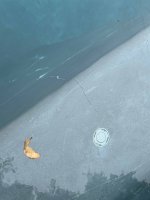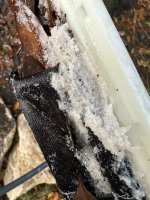Howdy,
I rolled back the cover to open my pool back on March 30th. The water was clear with some leaves and other tree debris on the floor, typical. So, I got out the pool robot and let 'er rip.
Upon cleaning out the first basket, I noticed that leaves had clogged the basket entrance but the basket wasn't full. Upon closer inspection, I found that the robot had picked up lots of white crystals and the crystals were tied up in the leaves which had ultimately caused the clog. Crystals were also stuck in the filters themselves.
I checked the bottom of the pool more closely and there were several piles of these crystals on the floor of the pool where the in floor cleaner jets sometimes accumulate debris. I let the robot clear the rest of the crystals. It took some brushing and several more runs of the robot. I tested the water with my Taylor kit from last season. 0 FC, 0 CC, pH off the charts, TA 90, CH 700. My CH reading was 30 points lower than when I closed the pool back on December 9th. We had some weather, spring live oak pollen fall, and some travel approaching, so I covered the pool again with the robot under the cover (cable fished through the skimmer cover, a genius move I discovered here), put in a little chlorine and acid to tide me over, and let it sit while occasionally running the robot.
Fast forward to today. I opened her back up and cleaned out the robot. I found more crystals in the filters, although significantly less than before. I've probably got most of them now. I also tested the water with a brand new Taylor kit to make sure I didn't get any false readings with old reagents. 0 FC, 0 CC, pH off the charts, TA 90, CH 630 (I accidentally overshot this CH reading, so wasn't exact). I dosed the pool with chlorine and acid and let the pool sit for a bit. After the chems I added had settled after about 3 hours of circulation I checked the numbers again. 5.5 FC, 0 CC, pH 7.0, TA 60, CH 580.
The difference in CH between when I closed the pool and now leads me to believe that calcium has precipitated out of my water. This hasn't happened to me before. In fact, I've been nursing a slow rise in CH over the years of owning my pool (this is season 5) by monitoring CSI and adjusting pH, not wanting to drain it. What I don't understand is what has caused this precipitation to happen. But, I have a theory.
I've been watching cracks appear in the floor of my pool for the last 2 seasons. The cracks were slight at first, but they've gotten worse, specifically over the winters during the last 2 years. This year upon opening the pool (while cleaning crystals) I noticed some new cracks along the vertical walls of the pool which is new. All previous cracks were on steps, seats, or floor. All this leads me to believe I'm one of the unlucky Central Texas residents to have installed a pool with defective concrete (ASR). Luckily, my pool was built into solid, very hard rock. We're on top of a hill and it took 9 weeks to jack hammer it (favorite neighbors!). So, if there are structural issues (i.e. cracks all the way through), there's no easy way to tell because the concrete was shot directly on top of rock and water literally has nowhere to leak. My water bill hasn't budged.
I'm trying to nurse this potential concrete cancer problem as long as I can. Thus far, it's only been aesthetic. However, these crystals give me pause about the safety of my pool water. Is there something now leaching from the concrete / plaster that has caused the crystal precipitation? Does this make my pool unsafe to swim in?
I've attached some photos of the crystals and the concrete cracks here. I'd love to hear from those that might be able to diagnose the cracks as ASR or not and comment on the safety of my pool in the conditions described above. Also, any ideas on what may have caused the calcium to precipitate (if that's what it is!) would also be super helpful. Appreciate your time and assistance!
I rolled back the cover to open my pool back on March 30th. The water was clear with some leaves and other tree debris on the floor, typical. So, I got out the pool robot and let 'er rip.
Upon cleaning out the first basket, I noticed that leaves had clogged the basket entrance but the basket wasn't full. Upon closer inspection, I found that the robot had picked up lots of white crystals and the crystals were tied up in the leaves which had ultimately caused the clog. Crystals were also stuck in the filters themselves.
I checked the bottom of the pool more closely and there were several piles of these crystals on the floor of the pool where the in floor cleaner jets sometimes accumulate debris. I let the robot clear the rest of the crystals. It took some brushing and several more runs of the robot. I tested the water with my Taylor kit from last season. 0 FC, 0 CC, pH off the charts, TA 90, CH 700. My CH reading was 30 points lower than when I closed the pool back on December 9th. We had some weather, spring live oak pollen fall, and some travel approaching, so I covered the pool again with the robot under the cover (cable fished through the skimmer cover, a genius move I discovered here), put in a little chlorine and acid to tide me over, and let it sit while occasionally running the robot.
Fast forward to today. I opened her back up and cleaned out the robot. I found more crystals in the filters, although significantly less than before. I've probably got most of them now. I also tested the water with a brand new Taylor kit to make sure I didn't get any false readings with old reagents. 0 FC, 0 CC, pH off the charts, TA 90, CH 630 (I accidentally overshot this CH reading, so wasn't exact). I dosed the pool with chlorine and acid and let the pool sit for a bit. After the chems I added had settled after about 3 hours of circulation I checked the numbers again. 5.5 FC, 0 CC, pH 7.0, TA 60, CH 580.
The difference in CH between when I closed the pool and now leads me to believe that calcium has precipitated out of my water. This hasn't happened to me before. In fact, I've been nursing a slow rise in CH over the years of owning my pool (this is season 5) by monitoring CSI and adjusting pH, not wanting to drain it. What I don't understand is what has caused this precipitation to happen. But, I have a theory.
I've been watching cracks appear in the floor of my pool for the last 2 seasons. The cracks were slight at first, but they've gotten worse, specifically over the winters during the last 2 years. This year upon opening the pool (while cleaning crystals) I noticed some new cracks along the vertical walls of the pool which is new. All previous cracks were on steps, seats, or floor. All this leads me to believe I'm one of the unlucky Central Texas residents to have installed a pool with defective concrete (ASR). Luckily, my pool was built into solid, very hard rock. We're on top of a hill and it took 9 weeks to jack hammer it (favorite neighbors!). So, if there are structural issues (i.e. cracks all the way through), there's no easy way to tell because the concrete was shot directly on top of rock and water literally has nowhere to leak. My water bill hasn't budged.
I'm trying to nurse this potential concrete cancer problem as long as I can. Thus far, it's only been aesthetic. However, these crystals give me pause about the safety of my pool water. Is there something now leaching from the concrete / plaster that has caused the crystal precipitation? Does this make my pool unsafe to swim in?
I've attached some photos of the crystals and the concrete cracks here. I'd love to hear from those that might be able to diagnose the cracks as ASR or not and comment on the safety of my pool in the conditions described above. Also, any ideas on what may have caused the calcium to precipitate (if that's what it is!) would also be super helpful. Appreciate your time and assistance!







